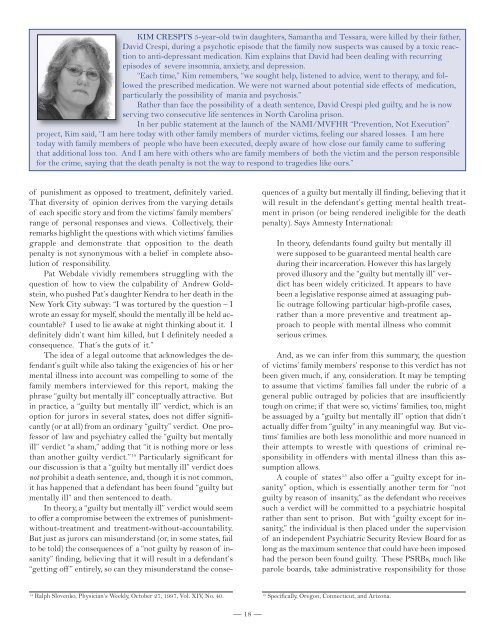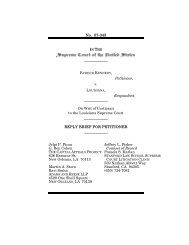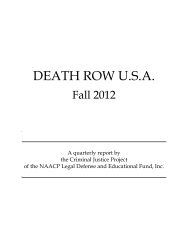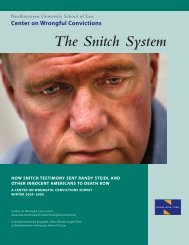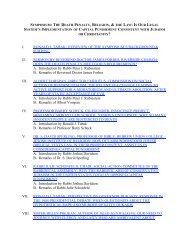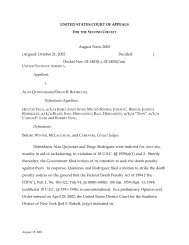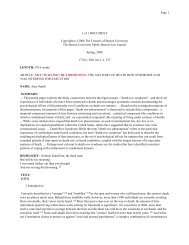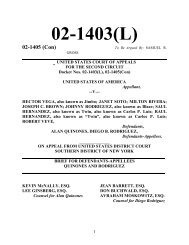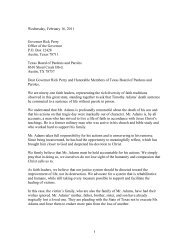Double Tragedies - Families for Human Rights
Double Tragedies - Families for Human Rights
Double Tragedies - Families for Human Rights
- No tags were found...
Create successful ePaper yourself
Turn your PDF publications into a flip-book with our unique Google optimized e-Paper software.
KIM CRESPI’S 5-year-old twin daughters, Samantha and Tessara, were killed by their father,David Crespi, during a psychotic episode that the family now suspects was caused by a toxic reactionto anti-depressant medication. Kim explains that David had been dealing with recurringepisodes of severe insomnia, anxiety, and depression.“Each time,” Kim remembers, “we sought help, listened to advice, went to therapy, and followedthe prescribed medication. We were not warned about potential side effects of medication,particularly the possibility of mania and psychosis.”Rather than face the possibility of a death sentence, David Crespi pled guilty, and he is nowserving two consecutive life sentences in North Carolina prison.In her public statement at the launch of the NAMI/MVFHR “Prevention, Not Execution”project, Kim said, “I am here today with other family members of murder victims, feeling our shared losses. I am heretoday with family members of people who have been executed, deeply aware of how close our family came to sufferingthat additional loss too. And I am here with others who are family members of both the victim and the person responsible<strong>for</strong> the crime, saying that the death penalty is not the way to respond to tragedies like ours.”of punishment as opposed to treatment, definitely varied.That diversity of opinion derives from the varying detailsof each specific story and from the victims’ family members’range of personal responses and views. Collectively, theirremarks highlight the questions with which victims’ familiesgrapple and demonstrate that opposition to the deathpenalty is not synonymous with a belief in complete absolutionof responsibility.Pat Webdale vividly remembers struggling with thequestion of how to view the culpability of Andrew Goldstein,who pushed Pat’s daughter Kendra to her death in theNew York City subway: “I was tortured by the question – Iwrote an essay <strong>for</strong> myself, should the mentally ill be held accountable?I used to lie awake at night thinking about it. Idefinitely didn’t want him killed, but I definitely needed aconsequence. That’s the guts of it.”The idea of a legal outcome that acknowledges the defendant’sguilt while also taking the exigencies of his or hermental illness into account was compelling to some of thefamily members interviewed <strong>for</strong> this report, making thephrase “guilty but mentally ill” conceptually attractive. Butin practice, a “guilty but mentally ill” verdict, which is anoption <strong>for</strong> jurors in several states, does not differ significantly(or at all) from an ordinary “guilty” verdict. One professorof law and psychiatry called the “guilty but mentallyill” verdict “a sham,” adding that “it is nothing more or lessthan another guilty verdict.” 14 Particularly significant <strong>for</strong>our discussion is that a “guilty but mentally ill” verdict doesnot prohibit a death sentence, and, though it is not common,it has happened that a defendant has been found “guilty butmentally ill” and then sentenced to death.In theory, a “guilty but mentally ill” verdict would seemto offer a compromise between the extremes of punishmentwithout-treatmentand treatment-without-accountability.But just as jurors can misunderstand (or, in some states, failto be told) the consequences of a “not guilty by reason of insanity”finding, believing that it will result in a defendant’s“getting off ” entirely, so can they misunderstand the consequencesof a guilty but mentally ill finding, believing that itwill result in the defendant’s getting mental health treatmentin prison (or being rendered ineligible <strong>for</strong> the deathpenalty). Says Amnesty International:In theory, defendants found guilty but mentally illwere supposed to be guaranteed mental health careduring their incarceration. However this has largelyproved illusory and the “guilty but mentally ill” verdicthas been widely criticized. It appears to havebeen a legislative response aimed at assuaging publicoutrage following particular high-profile cases,rather than a more preventive and treatment approachto people with mental illness who commitserious crimes.And, as we can infer from this summary, the questionof victims’ family members’ response to this verdict has notbeen given much, if any, consideration. It may be temptingto assume that victims’ families fall under the rubric of ageneral public outraged by policies that are insufficientlytough on crime; if that were so, victims’ families, too, mightbe assuaged by a “guilty but mentally ill” option that didn’tactually differ from “guilty” in any meaningful way. But victims’families are both less monolithic and more nuanced intheir attempts to wrestle with questions of criminal responsibilityin offenders with mental illness than this assumptionallows.A couple of states 15 also offer a “guilty except <strong>for</strong> insanity”option, which is essentially another term <strong>for</strong> “notguilty by reason of insanity,” as the defendant who receivessuch a verdict will be committed to a psychiatric hospitalrather than sent to prison. But with “guilty except <strong>for</strong> insanity,”the individual is then placed under the supervisionof an independent Psychiatric Security Review Board <strong>for</strong> aslong as the maximum sentence that could have been imposedhad the person been found guilty. These PSRBs, much likeparole boards, take administrative responsibility <strong>for</strong> those14Ralph Slovenko, Physician’s Weekly, October 27, 1997, Vol. XIV, No. 40.15Specifically, Oregon, Connecticut, and Arizona.__ 18 __


